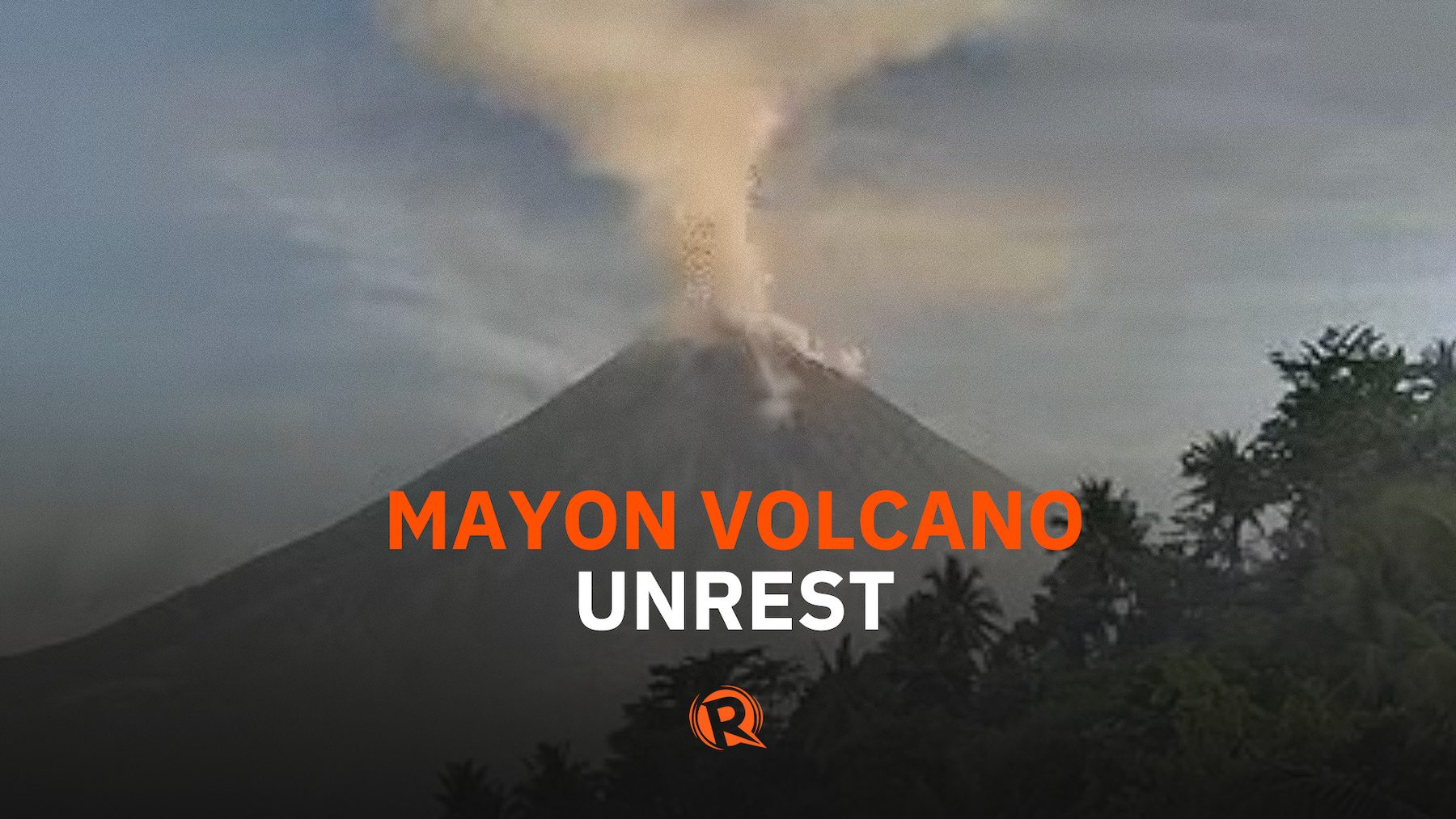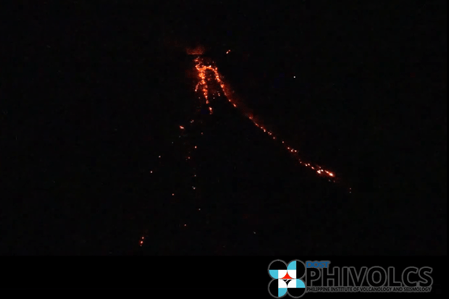WHAT YOU NEED TO KNOW
Albay province’s Mayon Volcano was downgraded to Alert Level 2 on December 8, six months after it was placed under Alert Level 3 on June 8.
The Philippine Institute of Volcanology and Seismology (Phivolcs) said the volcanic unrest has eased to a “moderate level,” but it is not completely over.
Entry into the 6-kilometer-radius permanent danger zone surrounding Mayon must remain prohibited.
Bookmark this page for Phivolcs bulletins, information on government response, updates about evacuations, and other news about Mayon Volcano.
LATEST UPDATES
Phivolcs bulletin, September 30, 8 am
Phivolcs reported the following in its Mayon Volcano bulletin issued at 8 am on Saturday, September 30, covering the past 24-hour period:
- 18 volcanic earthquakes
- 125 rockfall events
- 3 pyroclastic density currents (PDCs)
- lava flows maintained advances of 3.4 kilometers in Bonga (southeastern), 2.8 kilometers in Mi-isi (south), and 1.1 kilometers in Basud (eastern) gullies
- debris from rockfall and PDCs still deposited within 4 kilometers of the crater
- sulfur dioxide emission averaged 915 tons per day on Friday, September 29
- inflation or swelling of northwestern upper slopes since the fourth week of July and slight deflation of northwestern middle slope starting third week of September (short term); volcano still generally inflated relative to baseline levels (longer term)
Mayon Volcano has been under Alert Level 3 since June 8, which means it is “in a relatively high level of unrest,” according to Phivolcs. A hazardous eruption remains possible within weeks or even days.
Phivolcs bulletin, September 29, 8 am
Phivolcs reported the following in its Mayon Volcano bulletin issued at 8 am on Friday, September 29, covering the past 24-hour period:
- 18 volcanic earthquakes
- 95 rockfall events
- 3 pyroclastic density currents (PDCs)
- lava flows maintained advances of 3.4 kilometers in Bonga (southeastern), 2.8 kilometers in Mi-isi (south), and 1.1 kilometers in Basud (eastern) gullies
- debris from rockfall and PDCs still deposited within 4 kilometers of the crater
- sulfur dioxide emission averaged 761 tons per day on Thursday, September 28
- inflation or swelling of northwestern upper slopes since the fourth week of July and slight deflation of northwestern middle slope starting third week of September (short term); volcano still generally inflated relative to baseline levels (longer term)
Mayon Volcano has been under Alert Level 3 since June 8, which means it is “in a relatively high level of unrest,” according to Phivolcs. A hazardous eruption remains possible within weeks or even days.
Phivolcs bulletin, September 28, 8 am
Phivolcs reported the following in its Mayon Volcano bulletin issued at 8 am on Thursday, September 28, covering the past 24-hour period:
- 34 volcanic earthquakes including 1 tremor lasting 1 minute
- 144 rockfall events
- 1 pyroclastic density current (PDC)
- lava flows maintained advances of 3.4 kilometers in Bonga (southeastern), 2.8 kilometers in Mi-isi (south), and 1.1 kilometers in Basud (eastern) gullies
- debris from rockfall and PDCs still deposited within 4 kilometers of the crater
- sulfur dioxide emission averaged 875 tons per day on Wednesday, September 27
- inflation or swelling of northwestern upper slopes since the fourth week of July and slight deflation of northwestern middle slope starting third week of September (short term); volcano still generally inflated relative to baseline levels (longer term)
Mayon Volcano has been under Alert Level 3 since June 8, which means it is “in a relatively high level of unrest,” according to Phivolcs. A hazardous eruption remains possible within weeks or even days.
Phivolcs bulletin, September 27, 8 am
Phivolcs reported the following in its Mayon Volcano bulletin issued at 8 am on Wednesday, September 27, covering the past 24-hour period:
- 1 volcanic earthquake
- 68 rockfall events
- 3 pyroclastic density currents (PDCs)
- lava flows maintained advances of 3.4 kilometers in Bonga (southeastern), 2.8 kilometers in Mi-isi (south), and 1.1 kilometers in Basud (eastern) gullies
- debris from rockfall and PDCs still deposited within 4 kilometers of the crater
- sulfur dioxide emission averaged 923 tons per day on Tuesday, September 26
- inflation or swelling of northwestern upper slopes since the fourth week of July and slight deflation of northwestern middle slope starting third week of September (short term); volcano still generally inflated relative to baseline levels (longer term)
Mayon Volcano has been under Alert Level 3 since June 8, which means it is “in a relatively high level of unrest,” according to Phivolcs. A hazardous eruption remains possible within weeks or even days.
Phivolcs bulletin, September 26, 8 am
Phivolcs reported the following in its Mayon Volcano bulletin issued at 8 am on Tuesday, September 26, covering the past 24-hour period:
- 4 volcanic earthquakes
- 82 rockfall events
- 3 pyroclastic density currents (PDCs)
- lava flows maintained advances of 3.4 kilometers in Bonga (southeastern), 2.8 kilometers in Mi-isi (south), and 1.1 kilometers in Basud (eastern) gullies
- debris from rockfall and PDCs still deposited within 4 kilometers of the crater
- sulfur dioxide emission averaged 882 tons per day on Monday, September 25
- inflation or swelling of northwestern upper slopes since the fourth week of July and slight deflation of northwestern middle slope starting third week of September (short term); volcano still generally inflated relative to baseline levels (longer term)
Mayon Volcano has been under Alert Level 3 since June 8, which means it is “in a relatively high level of unrest,” according to Phivolcs. A hazardous eruption remains possible within weeks or even days.
Phivolcs bulletin, September 25, 8 am
Phivolcs reported the following in its Mayon Volcano bulletin issued at 8 am on Monday, September 25, covering the past 24-hour period:
- 4 volcanic earthquakes
- 128 rockfall events
- 1 pyroclastic density current (PDC)
- lava flows maintained advances of 3.4 kilometers in Bonga (southeastern), 2.8 kilometers in Mi-isi (south), and 1.1 kilometers in Basud (eastern) gullies
- debris from rockfall and PDCs still deposited within 4 kilometers of the crater
- sulfur dioxide emission averaged 1,074 tons per day on Sunday, September 24
- inflation or swelling of northwestern middle and upper slopes since the fourth week of July 2023 (short term); volcano still generally inflated relative to baseline levels (longer term)
Mayon Volcano has been under Alert Level 3 since June 8, which means it is “in a relatively high level of unrest,” according to Phivolcs. A hazardous eruption remains possible within weeks or even days.
Phivolcs bulletin, September 24, 8 am
Phivolcs reported the following in its Mayon Volcano bulletin issued at 8 am on Sunday, September 24, covering the past 24-hour period:
- 2 volcanic earthquakes
- 107 rockfall events
- 4 pyroclastic density currents (PDCs)
- lava flows maintained advances of 3.4 kilometers in Bonga (southeastern), 2.8 kilometers in Mi-isi (south), and 1.1 kilometers in Basud (eastern) gullies
- debris from rockfall and PDCs still deposited within 4 kilometers of the crater
- sulfur dioxide emission averaged 1,117 tons per day on Saturday, September 23
- inflation or swelling of northwestern middle and upper slopes since the fourth week of July 2023 (short term); volcano still generally inflated relative to baseline levels (longer term)
Mayon Volcano has been under Alert Level 3 since June 8, which means it is “in a relatively high level of unrest,” according to Phivolcs. A hazardous eruption remains possible within weeks or even days.
Phivolcs bulletin, September 23, 8 am
Phivolcs reported the following in its Mayon Volcano bulletin issued at 8 am on Saturday, September 23, covering the past 24-hour period:
- 5 volcanic earthquakes
- 139 rockfall events
- lava flows maintained advances of 3.4 kilometers in Bonga (southeastern), 2.8 kilometers in Mi-isi (south), and 1.1 kilometers in Basud (eastern) gullies
- debris from rockfall and pyroclastic density currents still deposited within 4 kilometers of the crater
- sulfur dioxide emission averaged 1,507 tons per day on Friday, September 22
- inflation or swelling of northwestern middle and upper slopes since the fourth week of July 2023 (short term); volcano still generally inflated relative to baseline levels (longer term)
Mayon Volcano has been under Alert Level 3 since June 8, which means it is “in a relatively high level of unrest,” according to Phivolcs. A hazardous eruption remains possible within weeks or even days.
Phivolcs bulletin, September 22, 8 am
Phivolcs reported the following in its Mayon Volcano bulletin issued at 8 am on Friday, September 22, covering the past 24-hour period:
- 15 volcanic earthquakes
- 162 rockfall events
- 2 pyroclastic density currents (PDCs)
- lava flows maintained advances of 3.4 kilometers in Bonga (southeastern), 2.8 kilometers in Mi-isi (south), and 1.1 kilometers in Basud (eastern) gullies
- debris from rockfall and PDCs still deposited within 4 kilometers of the crater
- sulfur dioxide emission averaged 868 tons per day on Wednesday, September 20 (last measurement taken)
- inflation or swelling of northwestern middle and upper slopes since the fourth week of July 2023 (short term); volcano still generally inflated relative to baseline levels (longer term)
Mayon Volcano has been under Alert Level 3 since June 8, which means it is “in a relatively high level of unrest,” according to Phivolcs. A hazardous eruption remains possible within weeks or even days.

